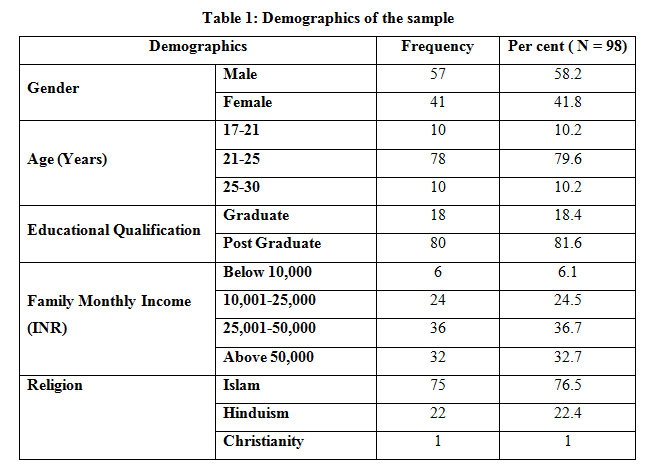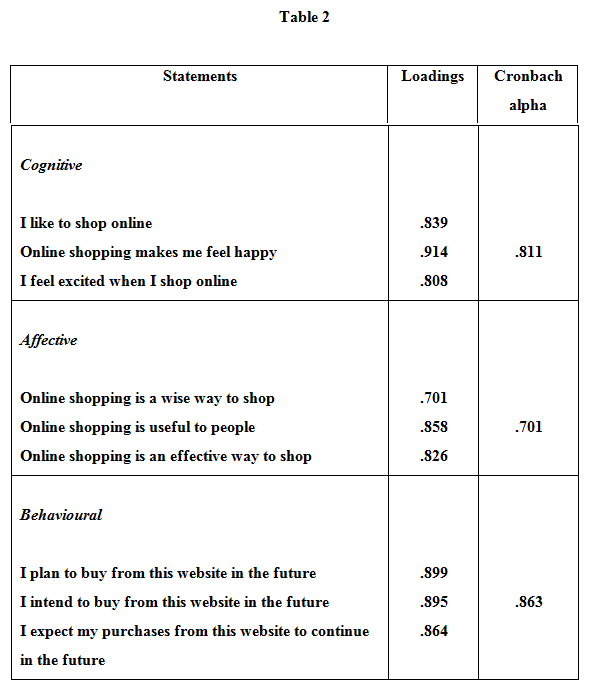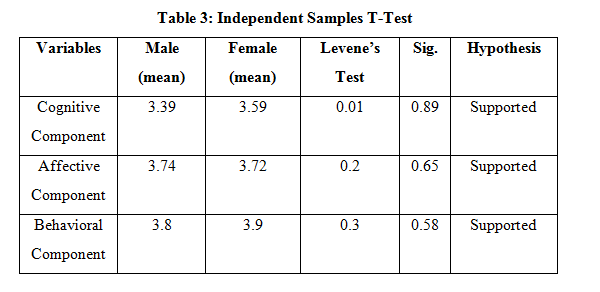|
S M Fatah Uddin (First Author) Research Scholar Department of Business Administration Aligarh Muslim University, India Email Id: smfateh87@gmail.com Mobile Number: +919760252543 |
Dr. Mohammed Naved Khan (Second Author) Associate Professor Department of Business Administration Aligarh Muslim University, India Email Id: mohdnavedkhan@gmail.com Mobile Number: +919557633713 |
Gender is an important variable when attitude is studied in order to understand the online consumer behaviour deeply. Still attitude has not been explored profoundly to get better revealing results in terms of online buying. Also very few studies addressed the gender differences in online shopping attitude, There is a dearth of literature available on online buying behaviour in Indian context. Considering attitude as a tri-component construct to contain cognitive, affective and behavioural constituents, the present study confirms the existence of the same three components. This study focuses on examining the gender differences across all three components of attitude to find whether significant differences exist or not. This study differentiates the three attitudinal components of the model and reveals that the gender differences were not found to exist between management students towards online buying. The study is of quite importance as the results add to the current literature with filling the void at same time in context emerging economy like India.
Keywords: Attitude, Online buying behaviour, Cognitive, Affective, Behavioural, Gender, Exploratory factor analysis
From our daily lives to commercial transactions between businesses, the Internet has deeply impacted and changed the way we do business.Use of the Internet for shopping, also called as e-tailing, has expanded immensely in recent years and has had a profound impact on the shopping process for many consumers around the globe. Internet sales continue to rise. In 2006, Internet sales rises to $100bn, showing Internet’s growth worldwide (Cassis, 2007). According to an e-commerce survey conducted by US based internet performance management company, Dyn, around 52% Indian shoppers prefer online store purchases and 89% respondents said they bought more online in 2015 in comparison to 2014. Behaviour towards a phenomenon is a result of combination of factors, however attitude toward online shopping isconsidered to be a significant predictor of online shopping behaviour (Ahn et al., 2007; Lin, 2007).
College going students specially management students have been regarded as the typical profile of the early adopters of online shopping. Cassis (2007) posits that college studentsspend hours using the Internet everyday and are most keen in buying online. However, as the internet has become more abundant, the profile of the online shopper has come to resemble the actual representation of population (Stores, 2001). For example, in the year 2000 in the USA, women comprised almost 60 percent of the online shoppers. Another study revealed that if number of Internet users is equally divided among the genders, more men than women engage in online shopping and make online purchases (Rodgers and Harris, 2003). Studies examining gender differences have been performed on constructs like perceived risk of online buying (Garbarino and Strahilevitze, 2004) and technology adoption (Sanchez-Franco, 2006) but in the context of Western cultures. However, there is a dearth of literature regarding investigative studies on gender differences in online buying attitudes in emerging economies like India. Some authors have reported their findings but the overall scenario is inconsistent (Cyr and Bonanni, 2005). Studies have suggested that there is positive inclination of Indian consumers towards E-commerce (Ahmad and Khan, 2015). Hence, this study aims to fill this void and examine online shopping attitude as a tri component model and probe gender differences in the cognitive, affective, and behavioural components of online shopping attitude.
Online consumer behaviour is studied widely using attitude surveys. Frameworks in consumer behaviour are available that can measure the attitude of respondents (Schiffman and Kanuk, 2000). Theory of reasoned action revealed the importance of attitude (Ajzen and Fishbein, 1980). Males have long been associated with computers while females have often been showed as not so linked with internet and technology; research has also revealed that that men’s attitude stay more or less the same while shopping online whereas women’s attitude can change in a considerable manner (Dittmar et al., 2004). Authors have tested whether gender difference exist on various psychological aspects related to online consumer behaviour like website trust and e-loyalty (Cyr and Bonanni, 2005), online shopping environment (Chang et al., 2005). Still results depicting relationships between attitude and online shopping are not collectively consistent across all the studies (Glassberg et al.,2006). Some researchers posit that the cause of fluctuations might be due to the cognitive component of the attitude while others proposed that affective component can be one of the causes for the deviations. Taking a cue from Breckler (1984) who suggested that attitude can be classified into cognitive, affective and behavioural component with a purpose of studying attitude deeply, we tried to study the effect of these three components on online buying behaviour.

Overall attitude towards an object, person, process, phenomenon etc |
On the basis of extant literature, following null hypotheses were proposed for the study:
H01: Significant differences do not exist between males and females in terms of cognitive component of attitude.
H02: Significant differences do not exist between males and females in terms of Affective component of attitude.
H03: Significant differences do not exist between males and females in terms of behavioural component of attitude.
Survey participants
Data was collected from 110 respondents in the form of paper and pencil surveys. Of these, 12 were eliminated based on incomplete responsesresulting in a sample of 98 final responses. For more accurate valuations of consumers’ attitude about online shopping, respondents were asked to give responses on the attitude that developed upon visiting the shopping site so that it was ensured that the attitude is based on online shopping (Bruner & Kumar, 2002).
Respondents were students enrolled in a Business Administration course at a premier institute near capitalcity of the country.Management students were selected because they are heavy buyers of clothing and other products representing the future of e-commerce (Ossorio, 1995; Silverman, 2000; Case and King, 2003). There were approximately 58 % male and 42 % female post graduate respondents in the final sample (See Table 1).

Following instructions and demographic questions, respondents completed Likert-type attitude items (using a five-point scale) whereby “1” Strongly Disagree and “5” indicates Strongly Agree” responds. Rating 3 is for respondents who feel they are just “Not Sure” with statements. Questionnaire comprises of nine statements to measure attitude of management students who shop online. The scale is based on the concept of tri component model for attitude formation and the items were adopted from Hassan (2010).
Exploratory factor analysis (EFA) was carried out to confirm the existence of affective, cognitive and behavioural components of attitude formation towards online shopping. Table 2 presents the results of the EFA and reliability analyses. All the items in the analysis, showed high loadings (>0.70) except one itemon their intended factors. Cronbach alpha was also calculated to evaluate the reliability of the variables considered for the research. All the constructs were found to be reliable having a value more than 0.60.The KMO measure of sampling adequacy for the items was 0.83 (that is > 0.6), indicating sufficient inter-correlations of the Bartlett’s Test of Sphericity, which was found to be significant (Chi-square = 397.216, p < 0.005).The univariate normality of the skewness and kurtosis values are calculated tomeasure the normality of the data. Researchers have suggested the value should lie within the range of ±3 (Churchill, 1995). In this study, all the values of skewness were falling in the acceptable zone as the values were between 0.035 and -0.684. The values of kurtosis were between 0.665 and -0.51. Hence all the items had univariate normal distributions.

In order to test hypotheses H01-H03, independent samples t-test was applied on the genders in terms of their attitudinal components towards online shopping. Based on the t-test results, H01, H02 and H03failed to be rejected. For the two genders, across the three attitudinal components, the results supported the considered hypotheses.

Results of this study validate and confirm the components which contribute in the overall formation of online buying attitude with respect to management students namely cognitive, affective and behavioural components. Gender difference was also examined for all the three underlying components to test whether significant dissimilarities exist or not in the perceptions of these students. Exploratory factor analysis revealed the existence of cognitive, affective and behavioural constituents of online buying attitude and helps in distinguishing the three components to extend the past studies on online shopping attitude to online buying behaviour.
Significant differencewere not found to exist between males and females with respect to the cognitive, affective and behavioural online shopping attitudes suggesting the consistency in the attitude of management students towards online buying. The results contradict findings of Sherman et al., (2000), but supports the report that the gender gap in internet shopping for products and services is declining (Department of Commerce, 2002; Sky News, 2002;Pew Internet and American Life, 2003).Authors posit that there exist gender differenceson various aspects related to online shopping but to the best of authors knowledge gender differences in the online buying behaviour of college going students specially management students were never been explored in Asian context. The cause of difference the might be allocated to the culture difference or the acceptance of technology at a later rate in Asian countries.
Every study is prone to some limitations and biases. This study has few limitations that are recognized while undergoing the analysis and interpretation of results. First, the sample elements comprise of management college student subjects, which may not be actual representative of the population of online buyers. However employing management students as sample elements is widely accepted and operationalized in various researches across different cultures(Ahuja et al.,2003).While we are confident of application and extension of our findings to other population, still there are chances of limited generalizability. Also the data was collected in India; generalizability of results to other nations might be limited due to cultural differences in their purchase behaviours. Third, this study did not measured actual buying behaviour. However the limitations do not pose any problem to the worth of the findings as the results are of great importance supported by empirical studies in the field of consumer behaviour instead add to the wealth of literature.
Online buying behaviour is a vast field for research and the pattern changes with time and this study is a small part of consumer buying attitude. Still several worthy areas of research for future developed after the conclusion of this research. A regression analysis can be done in order to find out which component of attitude is more significant and possess weightage in explaining online buying behaviour of online shoppers. Also the attitude formation can be studied and even gender differences can be examined on a sample possessing different demographic characteristics as online shopping does have an effect on age, income (Porter and Donthu, 2006).Researchers can also use various other techniques focus group interviews and qualitative methods to examine the relationship between attitude and consumer buying behaviour in the context of online buying. Also actual buying behaviour can be measured due to growing use of online shopping in all products and services.
Ahmad, A., & Khan, M. N.(2015). Mapping online buyer behavior : A critical review of empirical studies. Pacific Business Review International, 8(2), 37-48.
Ahuja, M., Gupta, B., & Raman, P. (2003). An empirical investigation of online consumer purchasing behavior. Communications of the ACM, 46(12), 145–151.
Ajzen, I., & Fishbein, M. (Eds.).(1980). Understanding attitudes and predicting social behaviour. New Jersey: Prentice-Hall.
Breckler, S. J. (1984). Empirical validation of affect, behavior, and cognition as distinct components of attitude. Journal of Personality and Social Psychology, 47, 1191–1205.
Bruner, G. C., & Kumar, A. (2002).Similarity analysis of three attitude-toward-the website scales. Quarterly Journal of Electronic Commerce, 3(2), 163–172.
Cassis, C. (2007) College students help fuel ever-growing Internet sales.[WWW document].URLhttp://media.www.dailyfreepress.com/media/storage/paper87/news/2007/01/22/News (accessed on 20 March 2007).
Chang, M. K., Cheung, W., & Lai, V. S. (2005). Literature derived reference models for
the adoption of online shopping. Information and Management, 42(4), 543–559.
Churchill, G.A. (1995), Marketing Research Methodological Foundations, 6th ed., The DrydenPress, Fort Worth, TX.
Cyr, D., &Bonanni, C. (2005). Gender and website design in e-business. International Journal of Electronic Business, 3(6), 565–582.
Department of Commerce (2002) Estimated quarterly US retail e-commerce sales. [WWW document].URL http://www.census.gov/mrts/current.html (accessed on 23 February 2006).
Dittmar, H., Long, K., & Meek, R. (2004).Buying on the Internet: Gender differences in on-line and conventional buying motivation. Sex Roles, 50(5–6), 423–444.
Garbarino, E., &Strahilevitze, M. (2004).Gender differences in the perceived risk of buying online and the effects of receiving a site recommendation. Journal of Business Research, 57(7), 768–775.
Glassberg, B. C., Grover, V., &Teng, J. T. C. (2006). Information system research with
an attitude. The Data Base for Advances in Information Systems, 37(2–3), 76–85.
Hassan, B. (2010). “Computers in Human Behavior 26 (2010) 597–601
John, S. (Feb 20, 2015). Majority of Indians prefers online to in-store purchases: Survey. [WWW document]. URL http://m.timesofindia.com/tech/tech-news/Majority-of-Indians-prefers-online-to-instore-prefers-online-to-in-store-purchases-sayssurvey/articlesshow/46307312.cms (Accessed on 20 February 2015)
Pew Internet and American Life (2003) The ever-shifting Internet population: a new look at Internet access and the digital divide. [WWW document].URL http://www.pewInternet.org/reports/toc.asp?Report=88 (accessed on 1 March 2006).
Porter, C. E., &Donthu, N. (2006). Using the technology acceptance model to explain how attitudes determine internet usage: The role of perceived access barriers and demographics. Journal of Business Research, 59(9), 999–1007.
Rodgers, S., and Harris, M. A. (2003). Gender and e-commerce: An exploratory study. Journal of Advertising Research, 43(3), 322–329.
Sanchez-Franco, M. J. (2006). Exploring the influence of gender on the Web usage via partial least squares. Behaviour and Information Technology, 25(1), 19–36.
Schiffmanlg and Kanuk ll. (2000) Consumer Behavior.Prentice-Hall, Upper Saddle River, NJ.
Sherman, R. C., End, C., Kraan, E., Cole, A., Campbell, J., Birchmeier, Z., et al. (2000). The Internet gender gapamong college students: Forgotten but not gone? Cyberpsychology&Behavior, 3, 885–894.
Silverman, D. (2000), “More women wardrobe online than ever”, Women’s Wear Daily, 31 july, pp. 20
Stores (2001), “Consumer trends in online shopping”, Vol. 83 No. 1, pp. 5-9.
Sky News (2002) UK survey sponsored by Barclays Bank.[WWWdocument].URL http://www/nua.ie/surveys/?f=VSandart_id=905357975andrel=true (accessed on 1 March 2006).